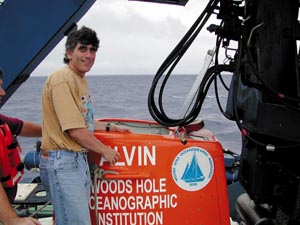|
10:03 a.m., Oct. 18, 2002--University of Delaware marine scientists will take students from around the world deep into the Pacific Ocean as part of Extreme 2002: Mission to the Abyss, a research expedition that will double as a “virtual field trip” for the study of hydrothermal vents and the unusual creatures that live there.
A 23-member scientific team led by UD marine biologist Craig Cary will set sail Sunday, Oct. 20, aboard the 274-foot research vessel Atlantis from San Diego, Calif., for a 24-day mission to the ocean depths that will continue through Nov. 12.
 |
| “This project is about getting kids excited about science,” UD marine biologist Craig Cary said. |
The team includes scientists from Amersham Biosciences, Arizona State University, Desert Research Institute, Scripps Institution of Oceanography, the University of Oregon, the University of Waikato (New Zealand), Woods Hole Oceanographic Institution and the Delaware Biotechnology Institute.
Once at the dive site along the East Pacific Rise, more than 1,000 miles west of Costa Rica, the scientists will climb into the submersible Alvin and plummet to one of the most demanding environments on Earth–super-hot hydrothermal vents nearly two miles deep on the ocean floor.
Under Cary’s direction, researchers will study the vents and the organisms that inhabit them, including the Pompeii worm, which is known as the world’s “hottest” animal because it is able to withstand temperatures up to 176 degrees Fahrenheit.
More than 41,000 students at more than 500 schools are participating in Extreme 2002. They represent 49 states, England, South Africa, Canada, Australia and New Zealand.
Starting Oct. 20, students and the public can log onto the expedition web site at [www.ocean.udel.edu/extreme2002] to see the scientists’ latest discoveries via video clips, photos, interviews and journals that will be relayed daily back to shore.
Students also will have an opportunity to interact electronically with members of the research team, and selected schools will participate in a live conference call with the scientists as they work in Alvin on the seafloor.
“This project is about getting kids excited about science,” Cary said. “We want to introduce them to one of the most fascinating habitats on the planet and engage them in the process of scientific research and discovery.”
Cary said participating schools include inner city schools, Native American schools and several schools in the heartland of America “where some of the kids have never seen the ocean and probably never will.”
The Internet and other electronic links to the classrooms provide for the students “real-time science at its best,” Cary added.
Hydrothermal vents are essentially geysers on the sea floor that continuously spew hot, mineral-rich water and help support a diverse community of exotic marine organisms, including towering tubeworms, eyeless shrimp and vent crabs.
Vent dwellers have adapted to some of the planet’s most demanding conditions–high temperature, high pressure and total darkness–and are the only complex ecosystem supported on energy from chemicals rather than energy from the sun.
The vents, some of which are topped by soaring chimneys, are believed to play an important role in the ocean’s temperature, chemistry and circulation patterns. Scientists also believe that if there is life on other planets, it might be similar to vent bacteria.
“Every time we dive to the vents, we find something new,” Cary said. “By studying ‘extremophiles’ like the Pompeii worm, we can better understand this amazing ecosystem and the human benefits it may yield.”
Cary said this mission will focus on research into how bacteria associated with the Pompeii worm adapt to changes in the environment. “Bacteria have been on the planet for more than 3.5 billion years and have an amazing capacity to ‘feel’ the environment,” he said. “Bacteria can sense very subtle changes in the environment and the question is, how does that work and how can we tap into that.”
Among its exploits, the research submarine Alvin is famous for first discovering giant tubeworms on the Pacific Ocean floor near the Galapagos Islands and for surveying the wreck of the Titanic. The sub is owned by the U.S. Navy and operated by Woods Hole Oceanographic Institution.
Extreme 2002: Mission to the Abyss is sponsored by the University of Delaware College of Marine Studies with primary funding from the National Science Foundation. Additional support has been provided by the National Oceanic and Atmospheric Administration’s National Sea Grant College Program, the MBNA Foundation and WHYY-TV, the Public Broadcasting System affiliate serving Wilmington and Philadelphia.
|

